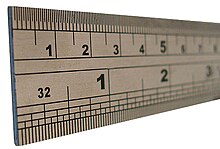
In number theory, the ruler function of an integer can be either of two closely related functions. One of these functions counts the number of times can be evenly divided by two, which for the numbers 1, 2, 3, ... is
0, 1, 0, 2, 0, 1, 0, 3, 0, 1, 0, 2, 0, 1, 0, 4, ... (sequence A007814 in the OEIS).Alternatively, the ruler function can be defined as the same numbers plus one, which for the numbers 1, 2, 3, ... produces the sequence
1, 2, 1, 3, 1, 2, 1, 4, 1, 2, 1, 3, 1, 2, 1, 5, ... (sequence A001511 in the OEIS).As well as being related by adding one, these two sequences are related in a different way: the second one can be formed from the first one by removing all the zeros, and the first one can be formed from the second one by adding zeros at the start and between every pair of numbers. For either definition of the ruler function, the rising and falling patterns of the values of this function resemble the lengths of marks on rulers with traditional units such as inches. These functions should be distinguished from Thomae's function, a function on real numbers which behaves similarly to the ruler function when restricted to the dyadic rational numbers.
In advanced mathematics, the 0-based ruler function is the 2-adic valuation of the number, and the lexicographically earliest infinite square-free word over the natural numbers. It also gives the position of the bit that changes at each step of the Gray code.
In the Tower of Hanoi puzzle, with the disks of the puzzle numbered in order by their size, the 1-based ruler function gives the number of the disk to move at each step in an optimal solution to the puzzle. A simulation of the puzzle, in conjunction with other methods for generating its optimal sequence of moves, can be used in an algorithm for generating the sequence of values of the ruler function in constant time per value.
References
- Erickson, Alejandro; Isgur, Abraham; Jackson, Bradley W.; Ruskey, Frank; Tanny, Stephen M. (January 2012). "Nested Recurrence Relations with Conolly-like Solutions". SIAM Journal on Discrete Mathematics. 26 (1): 206–238. arXiv:1509.02613. Bibcode:2015arXiv150902613E. doi:10.1137/100795425. ISSN 0895-4801. S2CID 8116882.
- Guay-Paquet, Mathieu; Shallit, Jeffrey (November 2009). "Avoiding squares and overlaps over the natural numbers". Discrete Mathematics. 309 (21): 6245–6254. arXiv:0901.1397. doi:10.1016/j.disc.2009.06.004. S2CID 8646044.
- ^ Herter, Felix; Rote, Günter (November 2018). "Loopless Gray code enumeration and the Tower of Bucharest". Theoretical Computer Science. 748: 40–54. arXiv:1604.06707. Bibcode:2016arXiv160406707H. doi:10.1016/j.tcs.2017.11.017. S2CID 4014870.
- Hinz, Andreas M.; Klavžar, Sandi; Milutinović, Uroš; Petr, Ciril (2013). The Tower of Hanoi – Myths and Maths. Basel: Springer Basel. pp. 60–61. doi:10.1007/978-3-0348-0237-6. ISBN 978-3-0348-0236-9.
External links
This number theory-related article is a stub. You can help Misplaced Pages by expanding it. |
 can be either of two closely related functions. One of these functions counts the number of times
can be either of two closely related functions. One of these functions counts the number of times